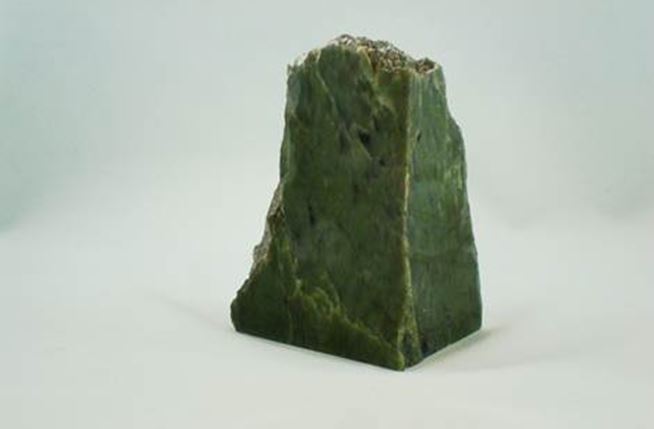First Nation moves to halt jade miners in northern B.C.

An example of jade mined in the Cassiar area of far northern British Columbia. Photo by Ellsworth Dickson
By Peter Kennedy

One of northern British Columbia’s First Nations is moving to have all jade exploration and mining as well as placer mining suspended on its traditional territory.
It is not clear what triggered the move by the Tahltan First Nation to halt the activities of jade miners who say they have been operating for decades in the Dease Lake area without incident.
In an interview, Calvin Carlick, Executive Director of the Tahltan First Nation Central government, said the action follows many years of unchecked jade extraction and placer mining on a traditional territory that covers 93,500 km2.
President Chad Norman Day of the Tahltan Central Government recently wrote a letter to the provincial government following conversations with senior staff at the B.C. Ministry of Energy, Mines, & Petroleum Resources.
In the letter, he said jade is an important resource to Tahltan culture and must only be utilized with the First Nation’s consent and in a manner that respects its culture. “Despite this, jade extraction and placer mining has continued in our territory for generations with minimal regulatory oversight and no compensation to our people,” he said.
He went on to write that present day proponents – and by extensions the provincial government – have failed to demonstrate respect for Tahltan culture and the environment and therefore do not have, nor have they ever had, the social license to continue operating in our territory.
Jade has long been considered a hard asset and a symbol of wealth, purity and spirituality in Asian countries like China. Nephrite grade jade, the type that is mined in British Columbia, sells for anywhere from $10 and $100 per kilogram depending on quality.
The world jade market is estimated at 300 tonnes per year, with three quarters of this material originating in B.C.
The best B.C. nephrite is bought by local artists and transformed into artwork which is made available for sale on the international market. The largest sculpture made from B.C. nephrite is likely the Buddha commissioned for the Wat Wat Dhammamongkol Monastery in Bangkok
It was carved from a 32-tonne boulder mined by Jade West was sold to the monastery in Bangkok for $350,000. The Buddha stands 9.1 metres high.
The Tahltan said there are at least 25 companies exploring for, or are extracting jade in First Nation’s Territory. The mining season can be as short as two months in northern B.C., and is dependent on weather conditions.
High pressure blueschist or eclogite grade metamorphic rocks, favourable for jadeitite exploration are found in the Bridge River, Pinci Lake, Dease Lake and Jennings River areas of B.C. Active mining occurs in three parts of the province, Dease Lake, Mount Ogden, and Cassiar.
Companies like Jade West Group and Cassiar Jade Contract who are working in the Dease Lake area, typically extract the jade using excavators and bulldozers. In the case of Jade West, the material is then shipped to a yard in Surrey, B.C., where it is sold primarily to Asian buyers, usually at silent auctions in October.
“We are not a big company by any means,” said Charles Lee, an operating manger with the Jade West Group. He said the company typically has anywhere from three to 10 people working on site, plus another three or four in administration.
Asked about the action taken by the Tahltan, he would only say that this is a “delicate situation,” one that the company is trying to resolve with the help of the B.C. government.
In response to questions about the possible impact of the Tahltan’s action, the B.C. Ministry of Energy, Mines, & Petroleum Resources released a statement to Resource World saying it is aware of the position the Tahltan have taken regarding their traditional territory but added that the Tahltan’s recent statements and positions do not limit the rights of claim or permit holders.
The B.C. government also said it encourages companies to establish positive working relationships with First Nations early in the mining development process to understand and respond to First Nations concerns.
In his letter to the B.C. government, Day indicated that the Tahltan is open to discussions with both the jade miners and the provincial government. “I welcome the opportunity to sit down with the provincial government, jade operators and placer miners to discuss how our concerns can be addressed in a responsible and fair manner,” he said.
“Until then, the Tahltan Nation will no longer tolerate the status quo and stands ready to assert Tahltan jurisdiction over our territory through any legal means necessary, including protest and court action,” he said.
“No jade or placer operators have the consent or support of the Tahltan Nation and there is no framework in place for Tahltans to co-manage in the regulatory oversight or sharing of benefits from these operations.”
In a statement provided to Resource World, the province of B.C. said government, along with First Nations and several exploration companies from B.C.’s northwest region have created the B.C. Regional Mining Alliance (BCRMA) to promote British Columbia’s mining opportunities internationally. The Alliance is a partnership between the Province, the Tahltan Central Government (TCG), the Nisga’a Lisims Government (NLG), the Association for Mineral Exploration, Dolly Varden Silver Corp. [DV-TSXV], Skeena Resources Ltd. [SKE-TSXV], IDM Mining Ltd. [IDM-TSXV] and GT Gold Corp. [GTT-TSXV].
